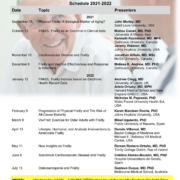Simplifying Frailty Assessment in Kidney Transplant Patients: Introducing the Abridged Frailty Phenotype

It’s widely known that frailty is associated with poor outcomes in surgical patients including kidney transplant patients. National projections estimate that 16.4% of transplant candidates and 14.3% of recipients are frail (Haugen et al, 2020). Remarkably, transplant centers that measure frailty achieve better pre- and post-operative outcomes (Chen et al, 2022). However, frailty assessments aren’t consistently used at transplant centers for many reasons, with time constraints being a significant barrier (McAdams-DeMarco et al, 2020). Therefore, we sought to create a more condensed frailty assessment that does not compromise on discrimination of clinical outcomes.
In our recent study published in The Journals of Gerontology, we propose a new frailty assessment, the abridged frailty phenotype (Chen et al, 2023). The abridged physical frailty phenotype was developed by simplifying the five physical frailty phenotype components (Fried et al, 2001) in a two-center prospective cohort of 3,220 kidney transplant candidates (Table 1). We found that the physical frailty phenotype and abridged assessment identified 23.8% and 27.4% candidates as frail, respectively. The abridged frailty physical phenotype had substantial agreement (kappa = 0.69, 95% CI: 0.66–0.71) with the physical frailty phenotype and excellent discrimination of it (AUC = 0.861). Among a subset of 20 patients at evaluation, the abridged assessment took 5–7 minutes to complete. The physical frailty phenotype and abridged assessment had similar associations with waitlist mortality (subdistribution hazard ratio [SHR] = 1.62, 95% CI: 1.26–2.08 vs SHR = 1.70, 95% CI: 1.33–2.16) and comparable mortality discrimination, using Harrell’s C-statistic (p = .51).
The results of this study support the use of this novel, validated light-touch frailty phenotype in clinical settings. It offers a cost-effective, objective measure of frailty that is both easier and more efficient to use when compared to the original physical frailty phenotype. Importantly, it maintains high accuracy in identifying frail and non-frail patients. Therefore, transplant departments should consider utilizing the abridged assessment to evaluate frailty in patients when time is limited.
It’s important to note that our aim is not to add yet another frailty assessment to the existing arsenal (Buta et al, 2016). In 2018, the American Society of Transplantation concluded that “a standard, validated measure of frailty is yet to be established” for the field (Kobashigawa et al, 2019). We hope that the abridged physical frailty phenotype can fill this gap and become universally accepted across disciplines. Standardization is essential when we discuss frailty; we must ensure that we are all speaking the same language by using consistent tools for measurement.
In conclusion, the development of the abridged physical frailty phenotype represents a step forward in improving the care and outcomes of our patients. Its simplicity, efficiency and effectiveness make it a valuable addition to the toolkit of providers and researchers alike, paving the way for standardized frailty assessment in the future.

This work was supported by NIH grant R01AG055781 (PI: McAdams-DeMarco). Dr. Quint was a visiting scholar at NYU Grossman School of Medicine while working on the publication.





